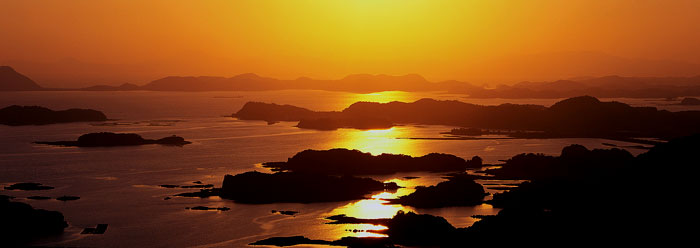
Earth Sciences Resources
Science cannot reproduce the catastrophic processes that shaped our planet's surface. The best that a scientist can do with the unobserved past is to evaluate the "clues" in the rocks and the fossils, and try to understand them in the light of present processes or with the comparison of forces on a much smaller scale. The issue of whether or not the worldwide Flood of Noah's day took place as described in the Bible makes enormous difference in how a geologist or paleontologist looks at the data entobmed in the rocks of the earth.
Topics
Resources» Next
Related Articles
Great Unconformity Best Solved by Global Flood
The Great Unconformity is one of the most baffling mysteries in the geological sciences.1 It is marked by a massive surface of erosion that appears all over the world at about the same time....
Secular Science Struggles to Explain Origin of Earth&rs.,.
Tim Clarey, Ph.D., and Jake Hebert, Ph.D.
Secular scientists continue to struggle to explain the origin of Earth’s water. And a new study published in Science calls into question their...
South American Plant Fossils Confirm Flood Boundary
Jeffrey P. Tomkins, Ph.D., and Tim Clarey, Ph.D.
Fossil pollen, leaf and fruit impressions, and petrified wood taken from multiple locations across the massive Central Andean Plateau in South...
Origin of Tectonic Plates Best Explained by the Flood
A new study published in Nature Communications claims to have figured out how the tectonic plates may have originated.1 It’s been over 50 years since the theory of plate tectonics became...
Great American Outdoors Act, Signed into Law by President
In a bipartisan legislative achievement to promote better stewardship of American public lands, U.S. Senators and Representatives finalized their bill (H.R. 1957) called the “Great American Outdoors...
Yellowstone Super-Eruptions Declining
Recently, renewed activity has had scientists, and the general public alike, alarmed about an impending supervolcano eruption at Yellowstone.1 However, as we predicted, this does not look to...
’Grand Canyon’ of Greenland Formed by Genes.,.
A massive canyon rivalling Grand Canyon has been discovered beneath the ice on Greenland, and uniformitarian scientists are explaining it as a consequence of flooding.1 We couldn’t agree...
World's Largest Volcano Found Hiding Under the Ocean
A new study published in Earth and Planetary Science Letters has determined that Puhahonu volcano is the world’s largest by volume and the hottest.1 Found almost 700 miles northwest of...
Another Attempt to Solve the Mystery of Plate Motion
The beginning of modern-style plate tectonics is another unsolved mystery in uniformitarian geology. No secular geologist seems to have a good answer. Some have even speculated that massive meteorites...
Plates Wobble Before Big Quakes
A new study published in Nature has found that tectonic plates may change directions rapidly, or “wobble,” several months before a massive quake is released.1 Scientists are not...
Predicting Volcanic Eruptions Using Muography
Recently, a new study published in Scientific Reports outlined a novel method to predict volcanic eruptions.1 However, the technique only seems to work on a site-by-site basis and requires a...
Predicting Earthquakes More Complex than Thought
The accurate prediction of an earthquake could potentially save thousands of lives. Everything from the study of strange animal behavior to satellites mapping changes in surface elevation have been employed...
Deepwater Oil Fields Have Small Environmental Footprint
Recently, geologist Harry S. Pettingill has found that deepwater oil and gas fields may be more environmentally friendly than first thought.1 In this day and age of trying to find an energy source that...
Massive Releases of CO2 from Mountain Streams
Recently, a new study published in Nature Communications found that mountain streams may be much larger contributors to the global carbon cycle than previously believed.1 The study suggests...
ICR Releases Game-Changing Flood Geology Book
The Institute for Creation Research (ICR) just released Carved in Stone: Geological Evidence of a Worldwide Flood, the second addition to ICR’s In-Depth Science series. Thanks to author Dr. Tim Clarey’s...
Earthquake Jolts Idaho
March went out with a jolt in central Idaho. March 31 saw a magnitude 6.5 earthquake strike about 45 miles west of the town of Challis at about 6:52 pm local time.1 The recent quake was about...
Earthquakes Still Active in Utah
On March 18, 2020, a 5.7 magnitude earthquake shook the Salt Lake City area. Specifically, it hit underneath the town of Magna, Utah. Since that time, over 650 aftershocks have continued to rumble through...
Volcanic Ash Turns to Stone in Months
How long does it take for the volcanic ash to turn to stone? Most uniformitarian scientists claim this is a slow process that should take many years, even thousands of years. But what does empirical science...
Yellowstone Supervolcano Unlikely to Blow
For several years, secular scientists have been predicting a possible supervolcano eruption at Yellowstone National Park. Recently, the London Daily Mail reported that the Norris Geyser Basin in Yellowstone...
Earthquake Causes Tsunami Fears
On Wednesday, March 25, 2020, a 7.8 magnitude earthquake struck just east of Russia’s Kuril Islands, sparking fears of impending tsunamis.1
According to the United States Geological...
Christians and Conservation
Why should Christians care about conservation? What is the “dominion mandate”? And how can we best steward the resources God has given us? Zoologist and Research Associate Frank Sherwin...
Mount St. Helens Recovery
The Mount St. Helens events give us a glimpse into Earth’s geologic power, the origin of rocks, and the formation of geologic features. How does the ecological recovery of Mount St. Helens...
Mount St. Helens: An Outdoor Laboratory
Geologist Dr. Steve Austin called the Mount St. Helens eruption “the geologic event of the twentieth century.” Mount St. Helens was not the largest volcano episode of the last century,...


























